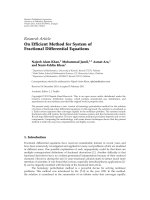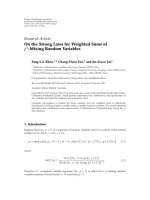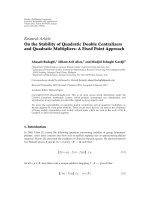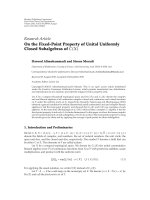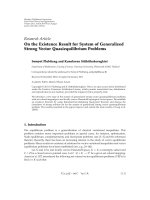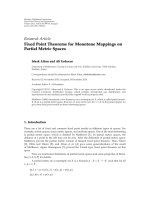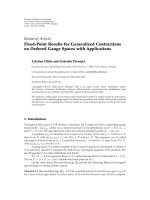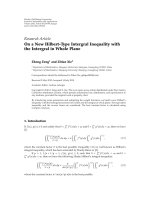Báo cáo hóa học: " Research Article On Complete Convergence for Arrays of Rowwise ρ-Mixing Random Variables and Its Applications" pdf
Bạn đang xem bản rút gọn của tài liệu. Xem và tải ngay bản đầy đủ của tài liệu tại đây (499.31 KB, 12 trang )
Hindawi Publishing Corporation
Journal of Inequalities and Applications
Volume 2010, Article ID 769201, 12 pages
doi:10.1155/2010/769201
Research Article
On Complete Convergence for Arrays of Rowwise
ρ-Mixing Random Variables and Its Applications
Xing-cai Zhou
1, 2
and Jin-guan Lin
1
1
Department of Mathematics, Southeast University, Nanjing 210096, China
2
Department of Mathematics and Computer Science, Tongling University, Tongling, Anhui 244000, China
Correspondence should be addressed to Jin-guan Lin,
Received 15 May 2010; Revised 23 August 2010; Accepted 21 October 2010
Academic Editor: Soo Hak Sung
Copyright q 2010 X c. Zhou and J g. Lin. This is an open access article distributed under the
Creative Commons Attribution License, which permits unrestricted use, distribution, and
reproduction in any medium, provided the original work is properly cited.
We give out a general method to prove the complete convergence for arrays of rowwise ρ-mixing
random variables and to present some results on complete convergence under some suitable
conditions. Some results generalize previous known results for rowwise independent random
variables.
1. Introduction
Let {Ω, F,P} be a probability space, and let {X
n
; n ≥ 1} be a sequence of random variables
defined on this space.
Definition 1.1. The sequence {X
n
; n ≥ 1} is said to be ρ-mixing if
ρ
n
sup
k≥1
sup
X∈L
2
F
k
1
,Y∈L
2
F
∞
nk
⎧
⎪
⎨
⎪
⎩
|
EXY − EXEY
|
E
X − EX
2
E
Y − EY
2
⎫
⎪
⎬
⎪
⎭
−→ 0 1.1
as n →∞, where F
n
m
denotes the σ-field generated by {X
i
; m ≤ i ≤ n}.
The ρ-mixing random variables were first introduced by Kolmogorov and Rozanov
1. The limiting behavior of ρ-mixing random variables is very rich, for example, these in
the study by Ibragimov 2, Peligrad 3,andBradley4 for central limit theorem; Peligrad
5 and Shao 6, 7 for weak invariance principle; Shao 8 for complete convergence; Shao
2 Journal of Inequalities and Applications
9 for almost sure invariance principle; Peligrad 10,Shao11 and Liang and Yang 12 for
convergence rate; Shao 11, for the maximal inequality, and so forth.
For arrays of rowwise independent random variables, complete convergence has
been extensively investigated see, e.g., Hu et al. 13,Sungetal.14, and Kruglov
et al. 15. Recently, complete convergence for arrays of rowwise dependent random
variables has been considered. We refer to Kuczmaszewska 16 for ρ-mixing and ρ-mixing
sequences, Kuczmaszewska 17 for negatively associated sequence, and Baek and Park 18
for negatively dependent sequence. In the paper, we study the complete convergence for
arrays of rowwise ρ-mixing sequence under some suitable conditions using the techniques
of Kuczmaszewska 16, 17. We consider the case of complete convergence of maximum
weighted sums, which is different from Kuczmaszewska 16. Some results also generalize
some previous known results for rowwise independent random variables.
Now, we present a few definitions needed in the coming part of this paper.
Definition 1.2. An array {X
ni
; i ≥ 1,n ≥ 1} of random variables is said to be stochastically
dominated by a random variable X if there exists a constant C, such that
P
{|
X
ni
|
>x
}
≤ CP
{
C
|
X
|
>x
}
1.2
for all x ≥ 0, i ≥ 1andn ≥ 1.
Definition 1.3. A real-valued function lx, positive and measurable on A, ∞ for some A>0,
is said to be slowly varying if
lim
x →∞
l
λx
l
x
1 for each λ>0.
1.3
Throughout the sequel, C will represent a positive constant although its value may
change from one appearance to the next; x indicates the maximum integer not larger than
x; IB denotes the indicator function of the set B.
The following lemmas will be useful in our study.
Lemma 1.4 Shao 11. Let {X
n
; n ≥ 1} be a sequence of ρ-mixing random variables with EX
i
0
and E|X
i
|
q
< ∞ for some q ≥ 2. Then there exists a positive constant K Kq, ρ· depending only
on q and ρ· such that for any n ≥ 1
E max
1≤i≤n
i
j1
X
j
q
≤ K
⎛
⎝
n
2/q
exp
⎛
⎝
K
log n
i0
ρ
2
i
⎞
⎠
max
1≤i≤n
E
|
X
i
|
2
q/2
n exp
⎛
⎝
K
log n
i0
ρ
2/q
2
i
⎞
⎠
max
1≤i≤n
E
|
X
i
|
q
⎞
⎠
.
1.4
Lemma 1.5 Sung 19. Let {X
n
; n ≥ 1} be a sequence of random variables which is stochastically
dominated by a random variable X. For any α>0 and b>0, the following statement holds:
E
|
X
n
|
α
I
|
X
n
|
≤ b
≤ C
E
|
X
|
α
I
|
X
|
≤ b
b
α
P
{|
X
|
>b
}
. 1.5
Journal of Inequalities and Applications 3
Lemma 1.6 Zhou 20. If lx > 0 is a slowly varying function as x →∞,then
i
m
n1
n
s
ln ≤ Cm
s1
lm for s>−1,
ii
∞
nm
n
s
ln ≤ Cm
s1
lm for s<−1.
This paper is organized as follows. In Section 2, we give the main result and its proof.
A few applications of the main result are provided in Section 3.
2. Main Result and Its Proof
This paper studies arrays of rowwise ρ-mixing sequence. Let ρ
n
i be the mixing coefficient
defined in Definition 1.1 for the nthrowofanarray{X
ni
; i ≥ 1,n ≥ 1}, that is, for the sequence
X
n1
,X
n2
, ,n≥ 1.
Now, we state our main result.
Theorem 2.1. Let {X
ni
; i ≥ 1,n ≥ 1} be an array of rowwise ρ-mixing random variables satisfying
sup
n
∞
i1
ρ
2/q
n
2
i
< ∞ for some q ≥ 2, and let {a
ni
; i ≥ 1,n ≥ 1} be an array of real numbers. Let
{b
n
; n ≥ 1} be an increasing sequence of positive integers, and let {c
n
; n ≥ 1} be a sequence of positive
real numbers. If for some 0 <t<2 and any ε>0 the following conditions are fulfilled:
a
∞
n1
c
n
b
n
i1
P{|a
ni
X
ni
|≥εb
1/t
n
} < ∞,
b
∞
n1
c
n
b
−q/t1
n
max
1≤i≤b
n
|a
ni
|
q
E|X
ni
|
q
I|a
ni
X
ni
| <εb
1/t
n
< ∞,
c
∞
n1
c
n
b
−q/tq/2
n
max
1≤i≤b
n
|a
ni
|
2
E|X
ni
|
2
I|a
ni
X
ni
| <εb
1/t
n
q/2
< ∞,
then
∞
n1
c
n
P
⎧
⎨
⎩
max
1≤i≤b
n
i
j1
a
nj
X
nj
− a
nj
EX
nj
I
a
nj
X
nj
<εb
1/t
n
>εb
1/t
n
⎫
⎬
⎭
< ∞. 2.1
Remark 2.2. Theorem 2.1 extends some results of Kuczmaszewska 17 to the case of arrays of
rowwise ρ-mixing sequence and generalizes the results of Kuczmaszewska 16 to the case of
maximum weighted sums.
Remark 2.3. Theorem 2.1 firstly gives the condition of the mixing coefficient, so the conditions
a–c do not contain the mixing coefficient. Thus, the conditions a–c are obviously
simpler than the conditions i–iii in Theorem 2.1 of Kuczmaszewska 16. Our conditions
are also different from those of Theorem 2.1 in the study by Kuczmaszewska 17: q ≥ 2is
only required in Theorem 2.1,notq>2 in Theorem 2.1 of Kuczmaszewska 17; the powers of
b
n
in b and c of Theorem 2.1 are −q/t 1and−q/t q/2, respectively, not −q/t in Theorem
2.1 of Kuczmaszewska 17.
Now, we give the proof of Theorem 2.1.
4 Journal of Inequalities and Applications
Proof. The conclusion of the theorem is obvious if
∞
n1
c
n
is convergent. Therefore, we will
consider that only
∞
n1
c
n
is divergent. Let
Y
nj
a
nj
X
nj
I
a
nj
X
nj
<εb
1/t
n
,T
ni
i
j1
Y
nj
,S
ni
i
j1
a
nj
X
nj
,
A
b
n
i1
{
a
ni
X
ni
Y
ni
}
,B
b
n
i1
{
a
ni
X
ni
/
Y
ni
}
.
2.2
Note that
P
max
1≤i≤b
n
|
S
ni
− ET
ni
|
>εb
1/t
n
P
max
1≤i≤b
n
|
S
ni
− ET
ni
|
>εb
1/t
n
A
P
max
1≤i≤b
n
|
S
ni
− ET
ni
|
>εb
1/t
n
B
≤ P
max
1≤i≤b
n
|
T
ni
− ET
ni
|
>εb
1/t
n
b
n
i1
P
|
a
ni
X
ni
|
>εb
1/t
n
.
2.3
By a it is enough to prove that for all ε>0
∞
n1
c
n
P
max
1≤i≤b
n
|
T
ni
− ET
ni
|
>εb
1/t
n
< ∞.
2.4
By Markov inequality and Lemma 1.4, and note that the assumption
sup
n
∞
i1
ρ
2/q
n
2
i
< ∞ for some q ≥ 2, we get
P
max
1≤i≤b
n
|
T
ni
− ET
ni
|
>εb
1/t
n
≤ Cb
−q/t
n
Emax
1≤i≤b
n
|
T
ni
− ET
ni
|
q
≤ Cb
−q/t
n
⎧
⎨
⎩
b
n
exp
⎛
⎝
K
log b
n
i0
ρ
2/q
n
2
i
⎞
⎠
max
1≤i≤b
n
E
|
a
ni
X
ni
|
q
× I
|
a
ni
X
ni
|
<εb
1/t
n
K exp
⎛
⎝
K
log b
n
i1
ρ
n
2
i
⎞
⎠
Journal of Inequalities and Applications 5
×
b
n
max
1≤i≤b
n
E
|
a
ni
X
ni
|
2
I
|
a
ni
X
ni
|
<εb
1/t
n
q/2
⎫
⎬
⎭
≤ Cb
−q/t1
n
max
1≤i≤b
n
|
a
ni
|
q
E
|
X
ni
|
q
I
|
a
ni
X
ni
|
<εb
1/t
n
Cb
−q/tq/2
n
max
1≤i≤b
n
|
a
ni
|
2
E
|
X
ni
|
2
I
|
a
ni
X
ni
|
<εb
1/t
n
q/2
.
2.5
From b, c,and2.5,weseethat2.4 holds.
3. Applications
Theorem 3.1. Let {X
ni
; i ≥ 1,n ≥ 1} be an array of rowwise ρ-mixing random variables satisfying
sup
n
∞
i1
ρ
2/q
n
2
i
< ∞ for some q ≥ 2, EX
ni
0, and E|X
ni
|
p
< ∞ for all n ≥ 1,i ≥ 1, and
1 ≤ p ≤ 2.Let{a
ni
; i ≥ 1,n ≥ 1} be an array of real numbers satisfying the condition
max
1≤i≤n
|
a
ni
|
p
E
|
X
ni
|
p
O
n
ν−1
, as n −→ ∞ ,
3.1
for some 0 <ν<2/q. Then for any ε>0 and αp ≥ 1
∞
n1
n
αp−2
P
⎧
⎨
⎩
max
1≤i≤n
i
j1
a
nj
X
nj
>εn
α
⎫
⎬
⎭
< ∞. 3.2
Proof. Put c
n
n
αp−2
, b
n
n,and1/t α in Theorem 2.1.By3.1,weget
∞
n1
c
n
b
n
i1
P
|
a
ni
X
ni
|
≥ εb
1/t
n
≤ C
∞
n1
n
αp−2
n
i1
n
−αp
|
a
ni
|
p
E
|
X
ni
|
p
≤ C
∞
n1
n
−1
max
1≤i≤n
|
a
ni
|
p
E
|
X
ni
|
p
≤ C
∞
n1
n
−2ν
< ∞,
∞
n1
c
n
b
−q/t1
n
max
1≤i≤b
n
E
|
a
ni
X
ni
|
q
I
|
a
ni
X
ni
|
<εb
1/t
n
≤ C
∞
n1
n
αp−2
n
−αq1
n
αq−p
max
1≤i≤n
|
a
ni
|
p
E
|
X
ni
|
p
≤ C
∞
n1
n
−2ν
< ∞,
∞
n1
c
n
b
−q/tq/2
n
max
1≤i≤b
n
E
|
a
ni
X
ni
|
2
I
|
a
ni
X
ni
|
<εb
1/t
n
q/2
6 Journal of Inequalities and Applications
≤ C
∞
n1
n
αp−2
n
−αqq/2
n
α2−pq/2
max
1≤i≤n
|
a
ni
|
p
E
|
X
ni
|
p
q/2
≤ C
∞
n1
n
αp1−q/2νq/2−1−1
< ∞
3.3
following from νq/2−1 < 0. By the assumption EX
ni
0forn ≥ 1, i ≥ 1andby3.1, we have
n
−α
max
1≤i≤n
i
j1
a
nj
EX
nj
I
a
nj
X
nj
<εn
α
≤ Cn
−α
n
j1
a
nj
EX
nj
I
a
nj
X
nj
<εn
α
≤ Cn
−α
n
j1
a
nj
EX
nj
I
a
nj
X
nj
≥ εn
α
≤ Cn
−αp
n
j1
a
nj
p
E
X
nj
p
≤Cn
−αp1
max
1≤j≤n
|a
nj
|
p
E|X
nj
|
p
≤Cn
−αpν
−→ 0, as n −→ ∞ ,
3.4
because ν<1andαp ≥ 1. Thus, we complete the proof of the theorem.
Theorem 3.2. Let {X
ni
; i ≥ 1,n ≥ 1} be an array of rowwise ρ-mixing random variables satisfying
sup
n
∞
i1
ρ
2/q
n
2
i
< ∞ for some q ≥ 2, EX
ni
0, and E|X
ni
|
p
< ∞ for all n ≥ 1,i ≥ 1, and
1 ≤ p ≤ 2. Let the random variables in each row be stochastically dominated by a random variable X,
such that E|X|
p
< ∞, and let {a
ni
; i ≥ 1,n ≥ 1} be an array of real numbers satisfying the condition
max
1≤i≤n
|
a
ni
|
p
O
n
ν−1
, as n −→ ∞ ,
3.5
for some 0 <ν<2/q. Then for any ε>0 and αp ≥ 1 3.2 holds.
Theorem 3.3. Let {X
ni
,n ≥ 1,i ≥ 1} be an array of rowwise ρ-mixing random variables satisfying
sup
n
∞
i1
ρ
2/q
n
2
i
< ∞ for some q ≥ 2 and EX
ni
0 for all n ≥ 1,i ≥ 1. Let the random variables in
each row be stochastically dominated by a random variable X, and let {a
ni
; i ≥ 1,n ≥ 1} be an array of
real numbers. If for some 0 <t<2, ν>1/2
sup
i≥1
|
a
ni
|
O
n
1/t−ν
,E
|
X
|
12/ν
< ∞,
3.6
Journal of Inequalities and Applications 7
then for any ε>0
∞
n1
P
⎧
⎨
⎩
max
1≤i≤n
i
j1
a
nj
X
nj
>εn
1/t
⎫
⎬
⎭
< ∞. 3.7
Proof. Take c
n
1andb
n
n for n ≥ 1. Then we see that a and b are satisfied. Indeed,
taking q ≥ max2, 1 2/ν,byLemma 1.5 and 3.6,weget
∞
n1
c
n
b
n
i1
P
|
a
ni
X
ni
|
≥ εb
1/t
n
∞
n1
n
i1
P
|
a
ni
X
ni
|
≥ εn
1/t
≤ C
∞
n1
n
i1
P
{|
X
|
≥ Cn
ν
}
C
∞
n1
n
∞
kn
P
Ck
ν
≤
|
X
|
<C
k 1
ν
≤ C
∞
k1
k
2
P
Ck
ν
≤
|
X
|
<C
k 1
ν
≤ CE
|
X
|
2/ν
< ∞,
∞
n1
c
n
b
−q/t1
n
max
1≤i≤b
n
|
a
ni
|
q
E
|
X
ni
|
q
I
|
a
ni
X
ni
|
<εb
1/t
n
≤ C
∞
n1
n
−q/t1
max
1≤i≤n
|
a
ni
|
q
E
|
X
|
q
I
|
a
ni
X
|
<εn
1/t
n
q/t
|
a
ni
|
q
P
|
a
ni
X
|
≥ εn
1/t
≤ C
∞
n1
n
−12/ν/t1
max
1≤i≤n
|
a
ni
|
12/ν
E
|
X
|
12/ν
C
∞
n1
n max
1≤i≤n
P
|
a
ni
X
|
≥ εn
1/t
≤ C
∞
n1
n
−12/ν/t1
sup
i≥1
|
a
ni
|
12/ν
E
|
X
|
12/ν
C
∞
n1
nP
{|
X
|
≥ Cn
ν
}
≤ C
∞
n1
n
−ν−1
E
|
X
|
12/ν
C
∞
n1
n
−ν−1
E
|
X
|
12/ν
≤ C
∞
n1
n
−ν−1
< ∞ 3.8
In order to prove that c holds, we consider the following two cases.
If ν>2, by Lemma 1.5, C
r
inequality, and 3.6, we have
∞
n1
c
n
b
−q/tq/2
n
max
1≤i≤b
n
|
a
ni
|
2
E
|
X
ni
|
2
I
|
a
ni
X
ni
|
<εb
1/t
n
q/2
≤ C
∞
n1
n
−q/tq/2
max
1≤i≤n
|
a
ni
|
2
E
|
X
|
2
I
|
a
ni
X
ni
|
<εn
1/t
q/2
8 Journal of Inequalities and Applications
C
∞
n1
n
q/2
max
1≤i≤n
P
|
a
ni
X
|
≥ εn
1/t
q/2
≤ C
∞
n1
n
−q/tq/2
n
1/t1−2/νq/2
max
1≤i≤n
|
a
ni
|
12/ν
E
|
X
|
12/ν
q/2
C
∞
n1
n
q/2
P
{|
X
|
≥ Cn
ν
}
q/2
≤ C
∞
n1
n
−q/tq/21/t1−2/νq/2
sup
i≥1
|
a
ni
|
12/νq/2
E
|
X
|
12/ν
q/2
C
∞
n1
n
q/2
n
−12/ννq/2
E
|
X
|
12/ν
q/2
≤ C
∞
n1
n
−ν1q/2
E
|
X
|
12/ν
q/2
< ∞.
3.9
If 1/2 <ν≤ 2, take q>2/2ν − 1. We have that 2ν − 1q/2 > 1. Note that in this case
E|X|
2
< ∞. We have
∞
n1
c
n
b
−q/tq/2
n
max
1≤i≤b
n
|
a
ni
|
2
E
|
X
ni
|
2
I
|
a
ni
X
ni
|
<εb
1/t
n
q/2
≤ C
∞
n1
n
−q/tq/2
max
1≤i≤n
|
a
ni
|
2
E
|
X
|
2
I
|
a
ni
X
ni
|
<εn
1/t
q/2
C
∞
n1
n
q/2
P{
|
X
|
≥ Cn
ν
}
q/2
≤ C
∞
n1
n
−q/tq/2
sup
i≥1
|
a
ni
|
q
E
|
X
|
2
q/2
C
∞
n1
n
q/2−νq
E
|
X
|
2
q/2
≤ C
∞
n1
n
−2ν−1q/2
E
|
X
|
2
q/2
< ∞. 3.10
The proof will be completed if we show that
n
−1/t
max
1≤i≤n
i
j1
a
nj
EX
nj
I
a
nj
X
ni
<εn
1/t
−→ 0, as n −→ ∞ . 3.11
Journal of Inequalities and Applications 9
Indeed, by Lemma 1.5, we have
n
−1/t
max
1≤i≤n
i
j1
a
nj
EX
nj
I
a
nj
X
ni
<εn
1/t
≤ Cn
−1/t
n
j1
a
nj
E
|
X
|
C
n
j1
P
a
nj
X
≥ εn
1/t
≤ Cn
−ν
E
|
X
|
CnP
{|
X
|
≥ εn
ν
}
≤ Cn
−ν
E
|
X
|
Cn
−ν1
E
|
X
|
12/ν
−→ 0, as n −→ ∞ .
3.12
Theorem 3.4. Let {X
ni
; i ≥ 1,n ≥ 1} be an array of rowwise ρ-mixing random variables satisfying
sup
n
∞
i1
ρ
2/q
n
2
i
< ∞ for some q ≥ 2, and let {a
ni
; i ≥ 1,n ≥ 1} be an array of real numbers. Let
lx > 0 be a slowly varying function as x →∞.Ifforsome0 <t<2 and real number λ, and any
ε>0 the following conditions are fulfilled:
A
∞
n1
n
λ
ln
n
i1
P{|a
ni
X
ni
|≥εn
1/t
} < ∞,
B
∞
n1
n
λ−q/t1
lnmax
1≤i≤n
E|a
ni
X
ni
|
q
I|a
ni
X
ni
| <εn
1/t
< ∞,
C
∞
n1
n
λ−q/tq/2
lnmax
1≤i≤n
|a
ni
|
2
E|X
ni
|
2
I|a
ni
X
ni
| <εn
1/t
q/2
< ∞,
then
∞
n1
n
λ
l
n
P
⎧
⎨
⎩
max
1≤i≤n
i
j1
a
nj
X
nj
− a
nj
EX
nj
I
a
nj
X
nj
<εn
1/t
>εn
1/t
⎫
⎬
⎭
< ∞. 3.13
Proof. Let c
n
n
λ
ln and b
n
n.UsingTheorem 2.1,weobtain3.13 easily.
Theorem 3.5. Let {X
ni
; i ≥ 1,n ≥ 1} be an array of rowwise ρ-mixing identically distributed random
variables satisfying
∞
i1
ρ
2/q
n
2
i
< ∞ for some q ≥ 2 and EX
11
0.Letlx > 0 be a slowly varying
function as x →∞.Ifforα>1/2, αp > 1, and 0 <t<2
E
|
X
11
|
αpt
l
|
X
11
|
t
< ∞, 3.14
then
∞
n1
n
αp−2
l
n
P
⎧
⎨
⎩
max
1≤i≤n
i
j1
X
nj
>εn
1/t
⎫
⎬
⎭
< ∞. 3.15
Proof. Put λ αp −2anda
ni
1forn ≥ 1,i≥ 1inTheorem 3.4. To prove 3.15, it is enough to
note that under the assumptions of Theorem 3.4, the conditions A–C of Theorem 3.4 hold.
10 Journal of Inequalities and Applications
By Lemma 1.6,weobtain
∞
n1
n
αp−1
l
n
P
|
X
11
|
>εn
1/t
∞
n1
n
αp−1
l
n
∞
mn
P
εm
1/t
<
|
X
11
|
≤ ε
m 1
1/t
≤ C
∞
m1
P
εm
1/t
<
|
X
11
|
≤ ε
m 1
1/t
m
n1
n
αp−1
l
n
≤ C
∞
m1
m
αp
l
m
P
εm
1/t
<
|
X
11
|
≤ ε
m 1
1/t
≤ CE
|
X
11
|
αpt
l
|
X
11
|
t
< ∞,
3.16
which proves that condition A is satisfied.
Taking q>max2,αpt, we have αp − q/t < 0. By Lemma 1.6, we have
∞
n1
n
αp−1−q/t
l
n
E
|
X
11
|
q
I
|
X
11
|
≤ εn
1/t
∞
n1
n
αp−1−q/t
l
n
n
m1
E
|
X
11
|
q
I
ε
m − 1
1/t
≤
|
X
11
|
<εm
1/t
≤ C
∞
m1
E
|
X
11
|
q
I
ε
m − 1
1/t
≤
|
X
11
|
<εm
1/t
∞
nm
n
αp−1−q/t
l
n
≤ C
∞
m1
m
αp−q/t
l
m
E
|
X
11
|
q
I
ε
m − 1
1/t
≤
|
X
11
|
<εm
1/t
≤ CE
|
X
11
|
αpt
l
|
X
11
|
t
< ∞,
3.17
which proves that B holds.
In order to prove that C holds, we consider t he following two cases.
If αpt < 2, take q>2. We have
∞
n1
n
αp−2−q/tq/2
l
n
E
|
X
11
|
2
I
|
X
11
|
<εn
1/t
q/2
≤ C
∞
n1
n
αp−2−q/tq/2
l
n
n
q/t−αpq/2
E
|
X
11
|
αpt
I
|
X
11
|
<εn
1/t
q/2
≤ C
∞
n1
n
αp−11−q/2−1
l
n
< ∞.
3.18
Journal of Inequalities and Applications 11
If αpt ≥ 2, take q>max2, 2tαp − 1/2 − t. We have αp − q/t q/2 < 1. Note that in
this case E|X
11
|
2
< ∞.Weobtain
∞
n1
n
αp−2−q/tq/2
l
n
E
|
X
11
|
2
I
|
X
11
|
<εn
1/t
q/2
≤ C
∞
n1
n
αp−2−q/tq/2
l
n
< ∞.
3.19
The proof will be completed if we show that
n
−1/t
max
1≤i≤n
i
j1
EX
nj
I
|
X
11
|
<εn
1/t
−→ 0, as n −→ ∞ . 3.20
If αpt < 1, then
n
−1/t
max
1≤i≤n
i
j1
EX
nj
I
|
X
11
|
<εn
1/t
≤ Cn
1−αp
E
|
X
11
|
αpt
−→ 0, as n −→ ∞ . 3.21
If αpt ≥ 1, note that EX
11
0, then
n
−1/t
max
1≤i≤n
i
j1
EX
nj
I
|
X
11
|
<εn
1/t
≤ n
−1/t1
EX
11
I
|
X
11
|
≥ εn
1/t
≤ Cn
1−αp
E
|
X
11
|
αpt
−→ 0, as n −→ ∞ .
3.22
We complete the proof of the theorem.
Noting that for typical slowly varying functions, lx1andlxlog x, we can get
the simpler formulas in the above theorems.
Acknowledgments
The authors thank the academic editor and the reviewers for comments that greatly improved
the paper. This work is partially supported by the Anhui P rovince College Excellent
Young Talents Fund Project of China no. 2009SQRZ176ZD and National Natural Science
Foundation of China nos. 11001052, 10871001, 10971097.
References
1 A. N. Kolmogorov and G. Rozanov, “On the strong mixing conditions of a stationary Gaussian
process,” Theory of Probability and Its Applications, vol. 2, pp. 222–227, 1960.
2 I. A. Ibragimov, “A note on the central limit theorem for dependent random variables,” Theory of
Probability and Its Applications, vol. 20, pp. 134–139, 1975.
3 M. Peligrad, “On the central limit theorem for ρ-mixing sequences of random variables,” The Annals
of Probability, vol. 15, no. 4, pp. 1387–1394, 1987.
12 Journal of Inequalities and Applications
4 R. C. Bradley, “A central limit theorem for stationary ρ-mixing sequences with infinite variance,” The
Annals of Probability, vol. 16, no. 1, pp. 313–332, 1988.
5 M. Peligrad, “Invariance principles for mixing sequences of random variables,” The Annals of
Probability, vol. 10, no. 4, pp. 968–981, 1982.
6 Q. M. Shao, “A remark on the invariance principle for ρ-mixing sequences of random variables,”
Chinese Annals of Mathematics Series A, vol. 9, no. 4, pp. 409–412, 1988.
7 Q. M. Shao, “On the invariance principle for ρ-mixing sequences of random variables,” Chinese Annals
of Mathematics Series B, vol. 10, no. 4, pp. 427–433, 1989.
8 Q. M. Shao, “Complete convergence of ρ-mixing sequences,” Acta Mathematica Sinica,vol.32,no.3,
pp. 377–393, 1989.
9 Q. M. Shao, “Almost sure invariance principles for mixing sequences of random variables,” Stochastic
Processes and Their Applications, vol. 48, no. 2, pp. 319–334, 1993.
10 M. Peligrad, “Convergence rates of the strong law for stationary mixing sequences,” Zeitschrift f
¨
ur
Wahrscheinlichkeitstheorie und Verwandte Gebiete, vol. 70, no. 2, pp. 307–314, 1985.
11 Q. M. Shao, “Maximal inequalities for partial sums of ρ-mixing sequences,” The Annals of Probability,
vol. 23, no. 2, pp. 948–965, 1995.
12 H. Liang and C. Yang, “A note of convergence rates for sums of ρ-mixing sequences,” Acta
Mathematicae Applicatae Sinica, vol. 15, no. 2, pp. 172–177, 1999.
13 T C. Hu, M. Ord
´
o
˜
nez Cabrera, S. H. Sung, and A. Volodin, “Complete convergence for arrays of
rowwise independent random variables,” Communications of the Korean Mathematical Society, vol. 18,
no. 2, pp. 375–383, 2003.
14 S. H. Sung, A. I. Volodin, and T C. Hu, “More on complete convergence for arrays,” Statistics &
Probability Letters, vol. 71, no. 4, pp. 303–311, 2005.
15 V. M. Kruglov, A. I. Volodin, and T C. Hu, “On complete convergence for arrays,” Statistics &
Probability Letters
, vol. 76, no. 15, pp. 1631–1640, 2006.
16 A. Kuczmaszewska, “On complete convergence for arrays of rowwise dependent random variables,”
Statistics & Probability Letters, vol. 77, no. 11, pp. 1050–1060, 2007.
17 A. Kuczmaszewska, “On complete convergence for arrays of rowwise negatively associated random
variables,” Statistics & Probability Letters, vol. 79, no. 1, pp. 116–124, 2009.
18 J I. Baek and S T. Park, “Convergence of weighted sums for arrays of negatively dependent random
variables and its applications,” Journal of Theoretical Probability, vol. 23, no. 2, pp. 362–377, 2010.
19 S. H. Sung, “Complete convergence for weighted sums of random variables,” Statistics & Probability
Letters, vol. 77, no. 3, pp. 303–311, 2007.
20 X. C. Zhou, “Complete moment convergence of moving average processes under ϕ-mixing
assumptions,” Statistics & Probability Letters, vol. 80, no. 5-6, pp. 285–292, 2010.
